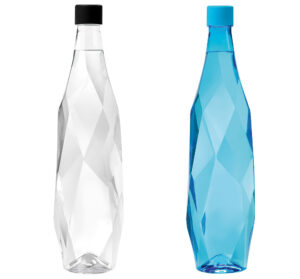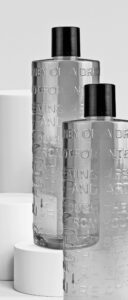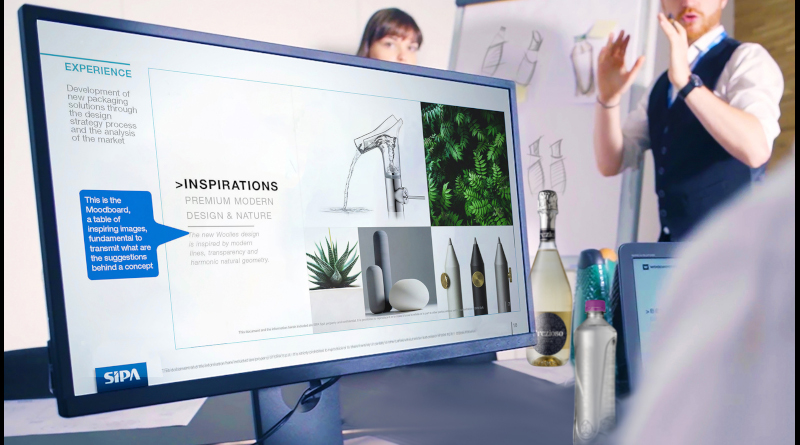A holistic approach to packaging design and development
From concept to finished bottle
Sipa’s capabilities in systems to produce preforms by injection moulding and using the Xtreme extrusion-injection-compression moulding technology are well-known; so is its position in bottle stretch-blow moulding, with both reheat systems and single-step injection-stretch-blow moulding, in moulds for preforms and for bottles to complement these moulding systems. The company’s design experts incorporate all this knowledge into the development of preforms and bottles, considering all the key parameters on the journey from the idea to a successful product. The company has built up a network of design centres across the world, in Europe, the USA, and China where a global team of experts, including 15 fully qualified industrial designers are busy. To produce bottle designs, many aspects have to be taken into account: What will the container contain? What specific markets it is aimed at? What is the sales strategy of the customer? Sipa’s design and engineering experts do not only have to consider the look of a container, but also how the look fits with the identity of the packaged product, how the container feels and behaves, how easy it is to produce, how it performs on the filling line, in storage, and in transport; and last but not least, how much it all costs.

Market expertise
The design and development team can apply its expertise not only to the container, but also to the label and/or other forms of decoration, and to the secondary packaging. Because the design centres are located in crucial end-user markets, staffed with experts steeped in local knowledge, they are positioned to create and develop ideas that best meet the needs of the specific customer and the target users. Local knowledge includes understanding of how markets are today, and how they are likely to develop, as consumer tastes change, and as new rules and regulations are introduced. In Europe, for example, environmental legislation is calling for single use bottles with tethered caps – caps that do not detach from the bottle when they are unscrewed, and so are less likely to disappear when the bottle has been emptied. New cap designs are likely to have important implications for bottle neck designs, and Sipa is already testing new versions. All these requirements and mechanisms to be considered go well beyond design. Sipa supports its design team with technical knowledge, assistance with market research and route-to-market strategies that will help the customer bring an idea into a commercial reality, sitting on the shop shelf in short time. This means that Sipa can speak to its customers from all points on the packaging circle – and it really is a circle, because Sipa has industry-leading experience and expertise in multiple aspects of recycling, from design for recycling, all the way through to processing post-consumer recyclate into good-as-new containers.
Design for recycling
Sipa strictly follows the Recyclass Design for Recycling guidelines established by EPBP, the European PET Bottle Platform. This voluntary industry initiative provides PET bottle design guidelines for recycling, evaluates PET bottle packaging solutions and technologies, and facilitates understanding of the effects of new PET bottle innovations on recycling processes. Several test procedures can be used to assess the impact on recycling of new packaging technologies.
How to use recyclate
Sipa says that it has considerable expertise in how to use post-consumer recycled PET in new containers for food and drink. This means not only creating designs that take into account differences and variations in processing characteristics of rPET, but also other less obvious factors such as the increased level of powder that rPET processing creates. The company recently established the Awarpet brand to advance its environmentally conscious approach to the design and production of PET packaging. Awarpet bottles are light: for example, Sipa has been involved in a design project for a 1l water bottle weighing just 16g, far lighter than most 1l bottles currently on the market.
It all starts with an idea
Any design project starts with a blank piece of paper (or possibly a blank iPad screen). Working with the most basic of briefs, the design experts can create a sophisticated concept, beginning with some fine-tuning of the original customer idea, moving to renderings and technical drawings, finite element analysis to simulate performance of the container, through to solid mock-ups. These can be produced in a short time using appropriate additive manufacturing (3D printing) techniques, before functional prototypes and finally market-ready products can be manufactured. “The customers can share their ideas with the team in complete confidence, since it is all one-on-one, with no external agencies involved. The expression ‘one-stop shop’ may be over-used sometimes, but in this case, it truly is applicable. Everything can be resolved in a seamless, integrated progression towards market success,” says Sipa.
The approach in action: successful projects
The Italian company has already applied the new packaging design and development service concept to several projects, including one that involved converting a barbeque sauce bottle from glass to hot-fill PET, maintaining the “retro” look of the original; and another for a customer employing the company’s Xtreme rotary injection-compression preform moulding system, for which an in-depth study of the impact on performance of different levels of PCR was assessed. Sipa has worked for a well-known Portuguese luxury mineral water brand to engineer the existing bottle base in order to make it possible to produce this magnificent bottle at high speed on its rotary blowmoulder Xtra while before it was produced on an alternative lower speed system.

Label free and lighter
Sipa’s design team has demonstrated their dedication to eco-conscious packaging by creating a range of aesthetically pleasing, functional, and environmentally friendly bottles. These bottles are uniquely devoid of labels, emphasising their commitment to recyclability. This approach not only minimises waste but also bestows a clean, sleek appearance, elevating the product’s overall aesthetic appeal. Furthermore, Sipa introduced a lightweight alternative to the standard PCO 1881 with the GME 30.37 neck finish, showcasing their expertise in engineering eco-friendly solutions. This neck finish achieves a 45.5% reduction in weight compared to previous designs while maintaining structural integrity. Importantly, it complies with the SUP Directive (2019/904), ensuring adherence to tethered cap regulations set to become effective by July 2024. The company’s bottle designs not only prioritise sustainability but also adhere to evolving industry standards, exemplifying their commitment to responsible packaging.
Withstanding high pressure: La Spumante
La Spumante is claimed to be the world’s first PET bottle designed exclusively for sparkling wine. Its unbreakable, lightweight design enhances safety, making it suitable for diverse events and venues, from concerts to airlines. The bottle’s commitment to sustainability, crafted entirely from PET or potentially rPET, significantly reduces its environmental footprint and seamlessly integrates with traditional bottling processes. Sipa says that La Spumante’s engineering withstands high pressures, preserving the effervescence and taste of sparkling wine. Moreover, the decrease of 80% in bottle weight compared to glass counterpart, leads to more efficient transportation, reducing costs and carbon emissions, aligning with sustainability goals. It has won multiple prices around the world.

